Enhanced Geographic Routing with One- and Two-Hop Movement Information in Opportunistic Ad Hoc Networks
Abstract
:1. Introduction
- All the location information regarding one-hop and two-hop relays and moving directions of two-hop relays with respect to any particular message-carrying node is exploited to select relay nodes moving closer to a destination node. Assuming high node density in the vicinity of a message-carrying node, one- and two-hop nodal information is thus leveraged to improve message forwarding.
- A combined weight measure is obtained using the DP values of one-hop and two-hop relays and the moving direction of the two-hop relay. This combined weight is compared with a threshold of weight value to take a message-forwarding decision.
- In the absence of two-hop relays, one-hop location information and the moving direction of the target node are exploited. This case is considered when fewer nodes are scattered in some geographic proximity. To resolve this case, the one-hop node’s centrality, which measures the node’s ability to communicate with other nodes in a network, is used to address the local maximum problem.
2. Related Work
3. System Model
3.1. OppNets Environment
3.2. Geometric Angle Formation
4. Scheme Design: MPMF
4.1. Design Abstraction
- The MPMF policy decides the best relay that is one out from a candidate set of one- or two-hop relay nodes which are moving closer to the destination and have frequent contacts with the destination node. If the candidate node is found, any message-carrying node should forward the messages in buffer to this candidate node as it is going to leave beyond the coverage of a two-hop distance and move closer to the destination.
- In presence of only one-hop relay with respect to a message-carrying node, a one-hop relay node is selected by considering its location and destination’s movement. A message-carrying node considers the destination’s and one-hop relay’s moving direction to take a forwarding decision. If the one-hop relay and the destination node are both moving in the same direction, the one-hop relay can be selected as a candidate node.
- An additional metric, i.e., centrality of a node, is used to avoid the situation that a message-carrying node continually carries its message if the one-hop relay is not moving toward the destination node. The centrality metric measures the ability of a node to communicate with other nodes in a network. A relay node with a higher centrality implies its effectiveness to deliver messages to the destination node and can be considered the best candidate node for the next message-forwarding action.
4.2. Relay Selection
4.2.1. Case 1
- 1.
- Summation angle measurement: The summation angle is used to indicate whether a relay node’s position is closer to a destination node.
- 2.
- DP’s weighting calculation in one-hop and two-hop distance levels: A relay node with more frequent contacts with a destination node will have a higher weight.
- 3.
- To select relay nodes, both one- and two-hop relays should be closer to the destination, their DP’s weight value calculated by considering their respective contact frequency with the destination should be higher, and the moving direction of the two-hop relay should be closer to the destination node.
4.2.2. Case 2
5. Message Forwarding
| Algorithm 1: Message Forwarding Policy. |
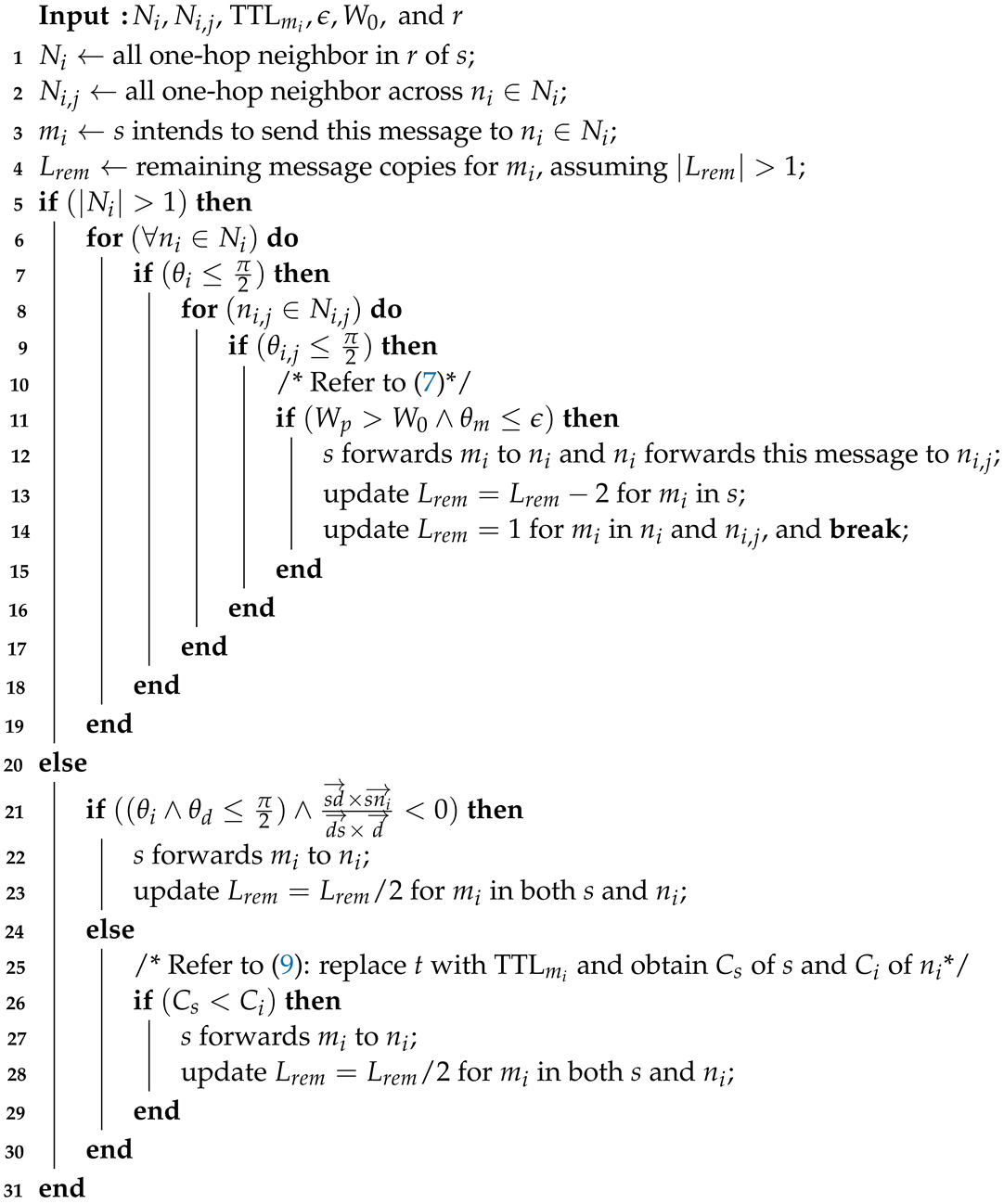 |
5.1. Message Forwarding in MPMF
- 1.
- Assuming that a message-carrying node encounters more than one node at the one-hop distance, i.e., case 1, the MPMF considers both one- and two-hop relays to receive only one message copy. Let s be the message-carrying node and create a new message for d. When a one-hop relay receives this message copy from s, it replicates this message to the two-hop-selected relay node. Node s then updates the remaining message copies, denoted as for the transferred message in its buffer, and both the one- and two-hop relays update in their respective buffers for the same message. Both nodes will transfer this message to the d only. However, s can continue to replicate the message to any encountered node until and then wait for d to transfer the message directly.
- 2.
- In the presence of only one relay at one-hop distance, i.e., case 2, a one-hop relay receives half of the remaining copies to distribute in the network. When s forwards a message to a one-hop relay, both s and the one-hop relay update copies for the message in their respective buffers. Then, both nodes can replicate this message further to other encountered nodes and reduce . When , the replication stops, and a relay node waits for the destination node to transfer the message.
5.2. Complexity
6. Performance Evaluation
6.1. Simulation Setting and Performance Metrics
6.1.1. Simulation Model and Node Mobility Scenarios
- The TVCM model is proposed to capture the realistic mobility characteristics observed from various WLANs, so it is suitable for the simulation of MANET and OppNets. In a TVCM-specific mobility scenario, 50, 100, and 150 mobile nodes move in an area of 1500 × 1500 m. Each node was randomly assigned to several community homes on a plane during the simulation. The simulation time was divided into equal time slots. The nodes moved in random waypoint trips in each time slot with a probability p of staying inside or (returning to) their homes and a probability of roaming outside their homes. By assigning different probabilities to each node, a wide range of heterogeneous node behavior can be reproduced.
- The NCCU dataset is a real trace dataset collected at the National Chengchi University campus. These data were collected using an Android app installed on the smartphones of students attending NCCU, Taiwan. The trace contains the data of GPS, Wi-Fi access points, and Bluetooth devices connected in physical communication proximity. The trace was collected from 115 students moving in 3764 × 3420 m over 15 days. The NCCU real dataset is available [29].
6.1.2. Experimental Cases
6.1.3. Evaluation Metrics
- Successful message delivery rate: This metric indicates the rate of the number of original messages created in the network to the number of distinct messages that were successfully received by their destinations during the simulation. With and , the measure turns out to the value of .
- Transmission overhead ratio: This metric is the ratio of the total times any original messages and replicas were transferred between intermediate nodes to the total amount of distinct messages received by their destinations during the simulation. With and , the overhead ratio is given as .
- Latency: This metric indicates the duration from the time instance which a message is generated by a source node to the time instance which the message is successfully received by its destination.
- Hop count: This measure is equal to the number of hops that a message has passed through during its delivery to the destination.
6.2. Sensitivity to MPMF’s Factors of , , L, and
6.3. Results by Epidemic, GSaR, TCCB, TC, and PRoPHETv2
6.3.1. Case (a)
6.3.2. Case (b)
6.3.3. Case (c)
7. Concluding Remarks and Future Work
Author Contributions
Funding
Institutional Review Board Statement
Informed Consent Statement
Data Availability Statement
Acknowledgments
Conflicts of Interest
Abbreviations
| MPMF | Message-forwarding policy based on movement patterns |
| TCCB | Temporal closeness and centrality-based |
| TC | Transient community-based |
| GSaR | Geographic-based spray-and-relay |
| OppNets | Opportunistic ad hoc networks |
| NCCU | National Chengchi University trace |
| TVCM | Time-variant community mobility model |
| ONE | Opportunistic networking environment |
| DP | Delivery probability |
| TTL | Time-to-live |
References
- Trifunovic, S.; Kouyoumdjieva, S.T.; Distl, B.; Pajevic, L.; Karlsson, G.; Plattner, B. A Decade of Research in Opportunistic Networks: Challenges, Relevance, and Future Directions. IEEE Commun. Mag. 2017, 55, 168–173. [Google Scholar] [CrossRef] [Green Version]
- Yao, L.; Wang, Y.; Wang, X.; Wu, G. Cooperative Caching in Vehicular Content Centric Network Based on Social Attributes and Mobility. IEEE Trans. Mob. Comput. 2021, 20, 391–402. [Google Scholar] [CrossRef]
- Gao, H.; Liu, C.; Li, Y.; Yang, X. V2VR: Reliable Hybrid-Network-Oriented V2V Data Transmission and Routing Considering RSUs and Connectivity Probability. IEEE Trans. Intell. Transp. Syst. 2021, 22, 3533–3546. [Google Scholar] [CrossRef]
- Cao, Y.; Sun, Z.; Wang, N.; Riaz, M.; Cruickshank, H.; Liu, X. Geographic-Based Spray-and-Relay (GSaR): An Efficient Routing Scheme for DTNs. IEEE Trans. Veh. Technol. 2015, 64, 1548–1564. [Google Scholar] [CrossRef]
- Cao, Y.; Wei, K.; Min, G.; Weng, J.; Yang, X.; Sun, Z. A Geographic Multicopy Routing Scheme for DTNs With Heterogeneous Mobility. IEEE Syst. J. 2018, 12, 790–801. [Google Scholar] [CrossRef]
- Hu, C.L.; Sosorburam, C. Enhanced Geographic Routing with Two-Hop Neighborhood Information in Sparse MANETs. Wirel. Pers. Commun. 2019, 107, 417–436. [Google Scholar] [CrossRef]
- Zhu, H.; Mir, M.Y.; Hu, C.L. Geographic Routing with Two-Hop Movement Information in Mobile Opportunistic Networks. In Proceedings of the 2021 30th Wireless and Optical Communications Conference (WOCC), Taipei, Taiwan, 7–8 October 2021; pp. 137–141. [Google Scholar]
- Cao, Y.; Sun, Z.; Wang, N.; Yao, F.; Cruickshank, H. Converge-and-Diverge: A Geographic Routing for Delay/Disruption-Tolerant Networks Using a Delegation Replication Approach. IEEE Trans. Veh. Technol. 2013, 62, 2339–2343. [Google Scholar] [CrossRef]
- Zhou, H.; Leung, V.C.M.; Zhu, C.; Xu, S.; Fan, J. Predicting Temporal Social Contact Patterns for Data Forwarding in Opportunistic Mobile Networks. IEEE Trans. Veh. Technol. 2017, 66, 10372–10383. [Google Scholar] [CrossRef]
- Samo Grasic, S.; Davies, E.; Lindgren, A.; Doria, A. The Evolution of a DTN Routing Protocol—PRoPHETv2. In Proceedings of the 2011 6th ACM workshop on Challenged Networks (CHANTS), Las Vegas, NV, USA, 19–23 September 2011; pp. 27–30. [Google Scholar]
- Iranmanesh, S.; Raad, R.; Chin, K.W. A novel destination-based routing protocol (DBRP) in DTNs. In Proceedings of the 2012 International Symposium on Communications and Information Technologies (ISCIT), Gold Coast, Australia, 2–5 October 2012; pp. 325–330. [Google Scholar]
- Li, F.; Jiang, H.; Li, H.; Cheng, Y.; Wang, Y. SEBAR: Social-Energy-Based Routing for Mobile Social Delay-Tolerant Networks. IEEE Trans. Veh. Technol. 2017, 66, 7195–7206. [Google Scholar] [CrossRef]
- Bi, X.; Qiu, T.; Qu, W.; Zhao, L.; Zhou, X.; Wu, D.O. Dynamically Transient Social Community Detection for Mobile Social Networks. IEEE Internet Things J. 2021, 8, 1282–1293. [Google Scholar] [CrossRef]
- Cao, Y.; Sun, Z.; Cruickshank, H.; Yao, F. Approach-and-Roam (AaR): A Geographic Routing Scheme for Delay/Disruption Tolerant Networks. IEEE Trans. Veh. Technol. 2014, 63, 266–281. [Google Scholar] [CrossRef]
- Singh, I.B.; Ho, Q.D.; Le-Ngoc, T. TIEGeR: An Energy-Efficient Multi-Parameter Geographic Routing Algorithm. In Proceedings of the 2012 IEEE Vehicular Technology Conference (VTC-Fall), Quebec City, QC, Canada, 3–6 September 2012; pp. 1–5. [Google Scholar]
- Bayhan, S.; Hyytiä, E.; Kangasharju, J.; Ott, J. Two Hops or More: On Hop-Limited Search in Opportunistic Networks. In Proceedings of the ACM International Conference on Modeling, Analysis and Simulation of Wireless and Mobile Systems (MSWiM), Cancun, Mexico, 2–6 November 2015; pp. 115–124. [Google Scholar]
- Hsu, W.J.; Spyropoulos, T.; Psounis, K.; Helmy, A. Modeling Spatial and Temporal Dependencies of User Mobility in Wireless Mobile Networks, Rome, Italy. IEEE/ACM Trans. Netw. 2009, 17, 1564–1577. [Google Scholar]
- Tsai, T.C.; Chan, H.H. NCCU Trace: Social-Network-Aware Mobility Trace. IEEE Commun. Mag. 2015, 53, 144–149. [Google Scholar] [CrossRef]
- Vahdat, A.; Becker, D. Epidemic Routing for Partially-Connected Ad Hoc Networks; Technical Report; Duke University: Durham, NC, USA, 2000. [Google Scholar]
- Zhang, X.; Cao, G. Transient Community Detection and Its Application to Data Forwarding in Delay Tolerant Networks. IEEE/ACM Trans. Netw. 2017, 25, 2829–2843. [Google Scholar] [CrossRef]
- Nelson, S.C.; Bakht, M.; Kravets, R. Encounter-Based Routing in DTNs. In Proceedings of the IEEE INFOCOM’09, Rio de Janeiro, Brazil, 19–25 April 2009; pp. 846–854. [Google Scholar]
- Spyropoulos, T.; Turletti, T.; Obraczka, K. Routing in Delay-Tolerant Networks Comprising Heterogeneous Node Populations. IEEE Trans. Mob. Comput. 2009, 8, 1132–1147. [Google Scholar] [CrossRef]
- Soares, V.N.G.J.; Rodrigues, J.J.P.C.; Farahmand, F. GeoSpray: A geographic routing protocol for vehicular delay-tolerant networks. Inf. Fusion 2014, 15, 102–113. [Google Scholar] [CrossRef]
- Sandulescu, G.; Schaffer, P.; Nadjm-Tehrani, S. Exploiting resource heterogeneity in delay-tolerant networks. Wirel. Commun. Mob. Comput. 2013, 13, 230–243. [Google Scholar] [CrossRef] [Green Version]
- Xie, G.; Chen, N. A Social-Aware Opportunistic Network Routing Protocol Based on the Node Embeddings. In Proceedings of the IEEE 89th Vehicular Technology Conference (VTC-Spring), Kuala Lumpur, Malaysia, 28 April–1 May 2019; pp. 1–5. [Google Scholar]
- Tao, J.; Wu, H.; Shi, S.; Hu, J.; Gao, Y. Contacts-aware opportunistic forwarding in mobile social networks: A community perspective. In Proceedings of the 2018 IEEE Wireless Communications and Networking Conference (WCNC), Barcelona, Spain, 15–18 April 2018; pp. 1–6. [Google Scholar]
- Hsu, Y.F.; Hu, C.L. Enhanced Buffer Management for Data Delivery to Multiple Destinations in DTNs. IEEE Trans. Veh. Technol. 2016, 65, 8735–8739. [Google Scholar] [CrossRef]
- Keränen, A.; Ott, J.; Kärkkäinen, T. The ONE Simulator for DTN protocol evaluation. In Proceedings of the 2nd International Conference on Simulation Tools and Techniques (SIMUTools), Rome, Italy, 2–6 March 2009; pp. 55:1–55:10. [Google Scholar]
- Tsai, T.C.; Chan, H.H. NCCU Trace: Social-Network-Aware Mobility Trace. 2013. Available online: https://github.com/NCCU-MCLAB/NCCU-Trace-Data (accessed on 1 March 2022).
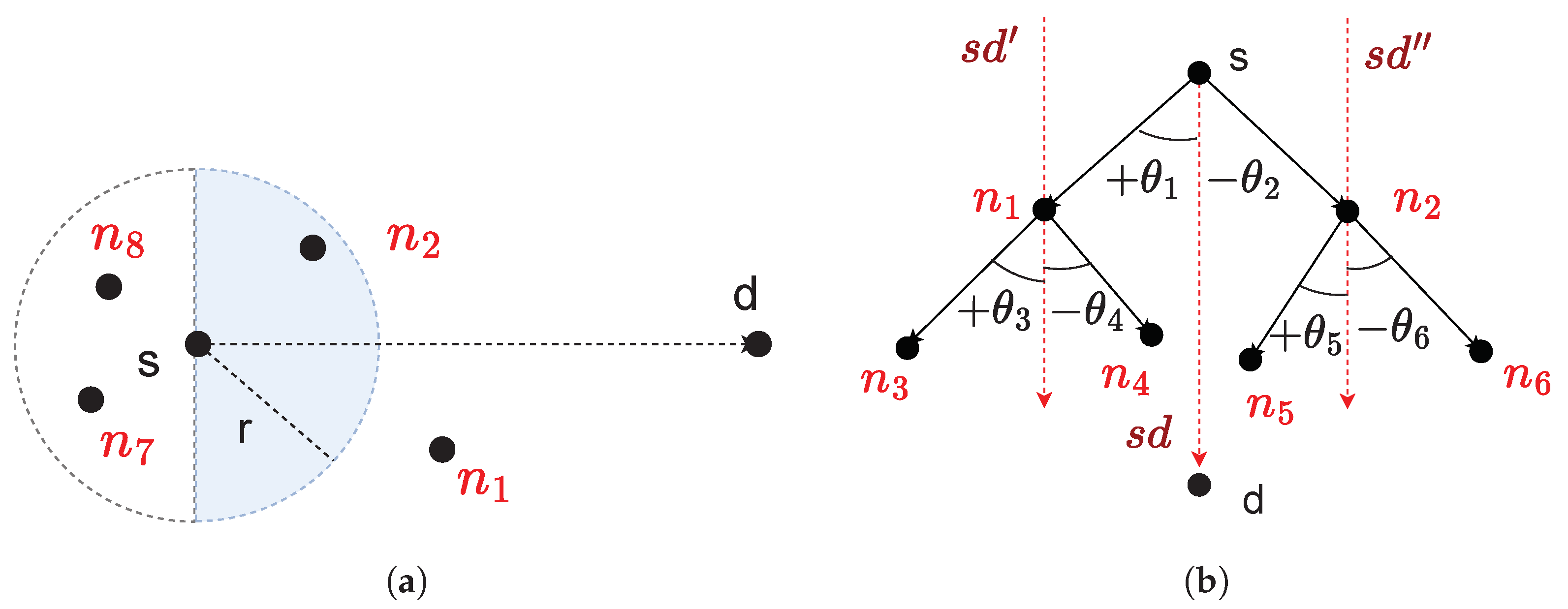
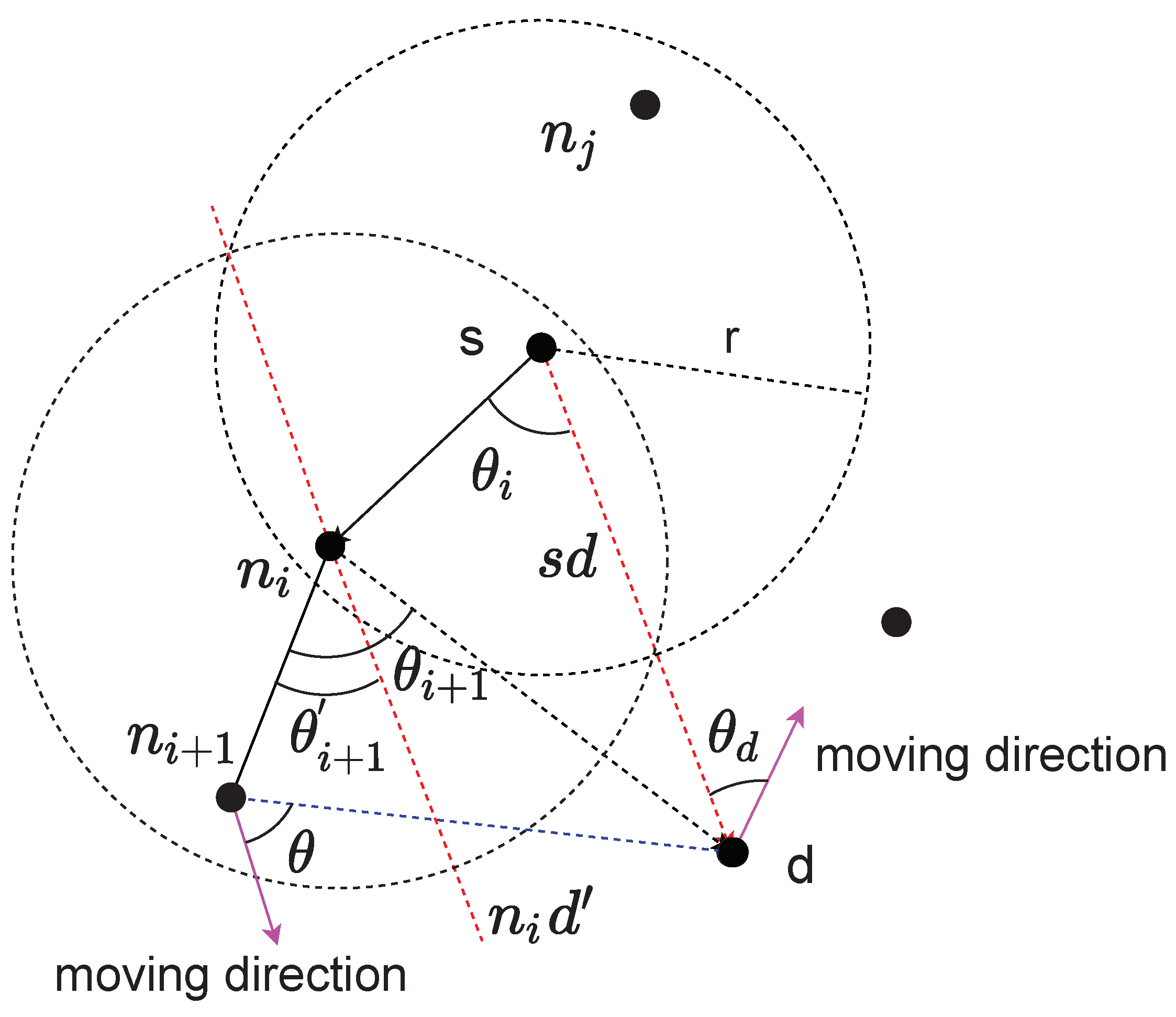
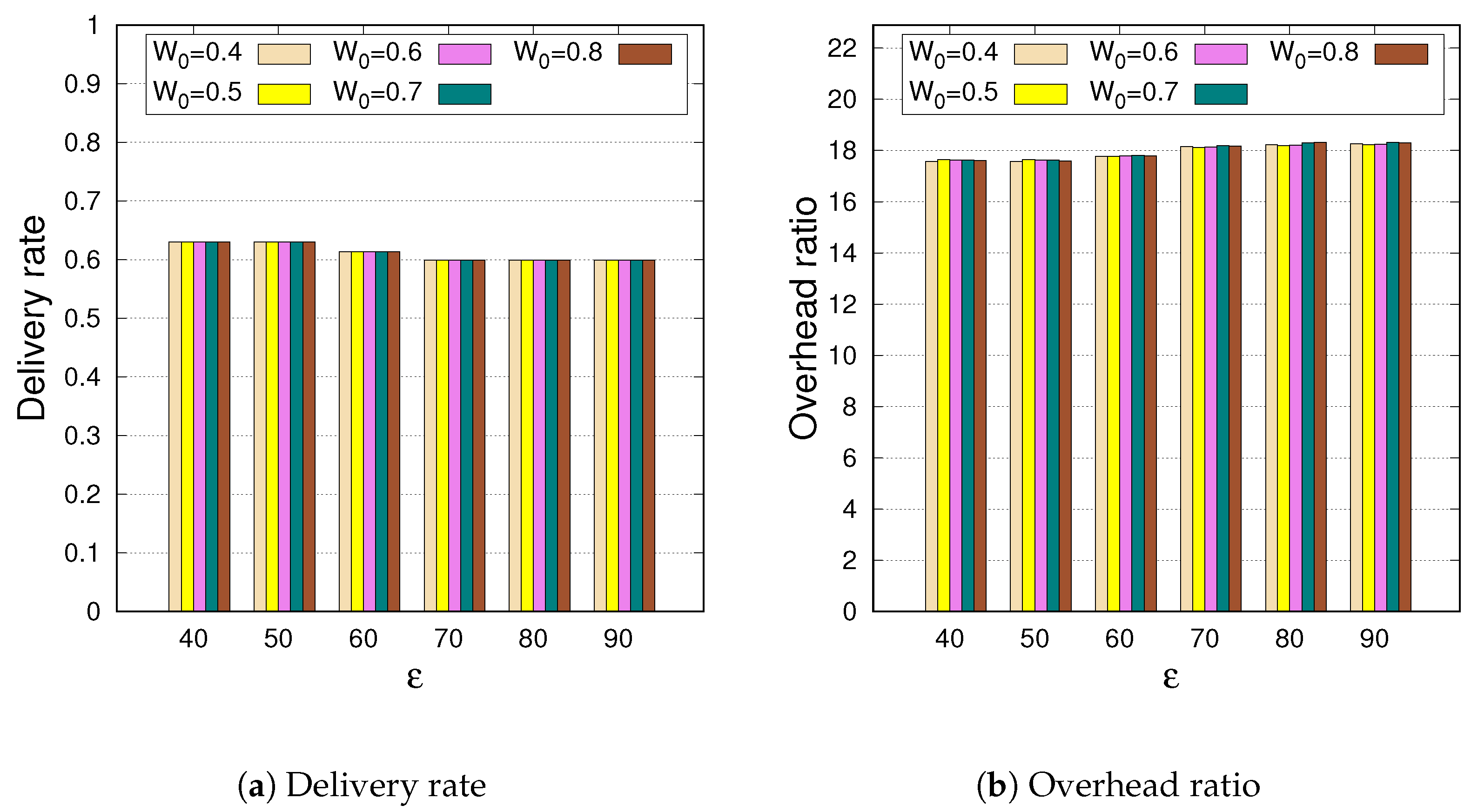
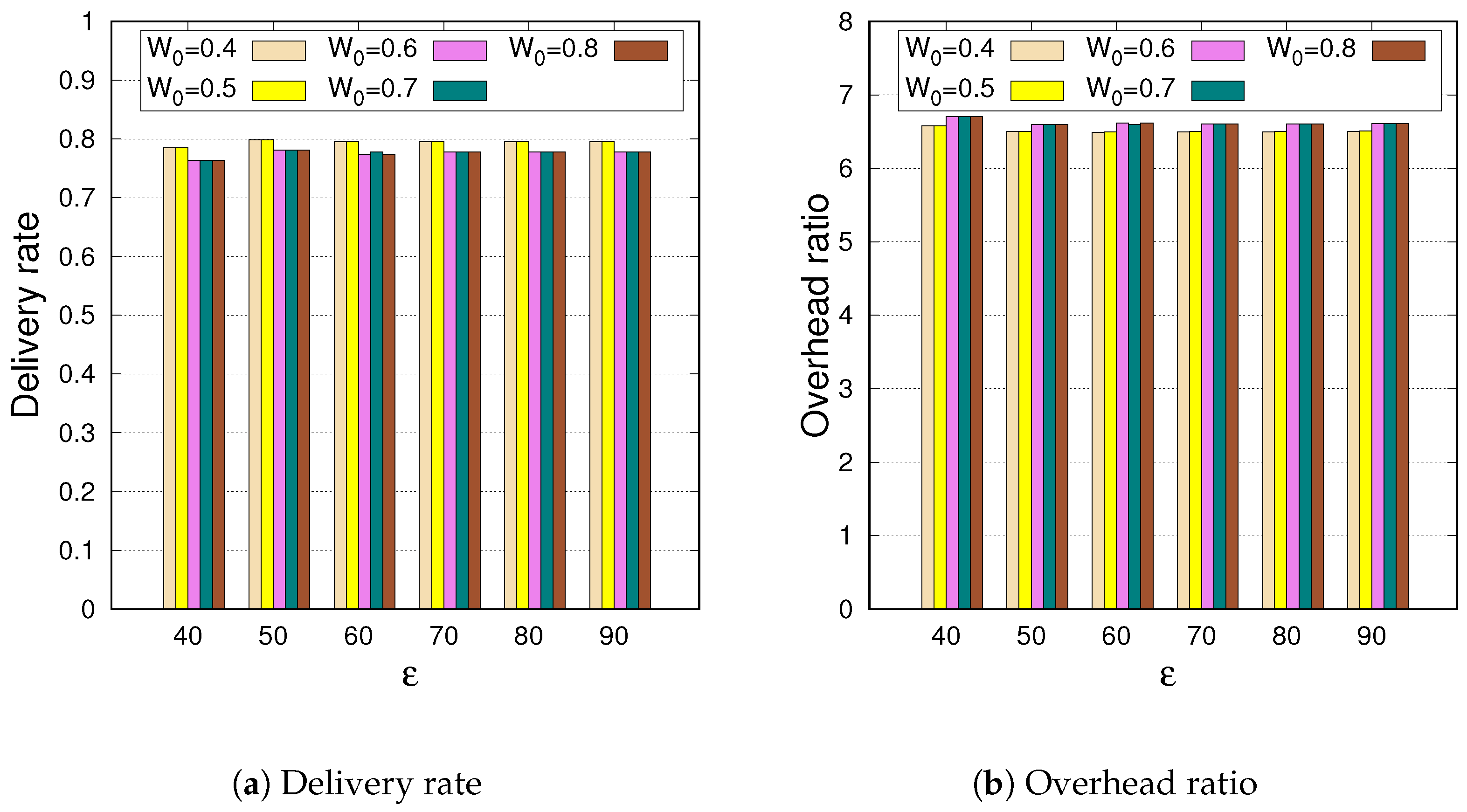
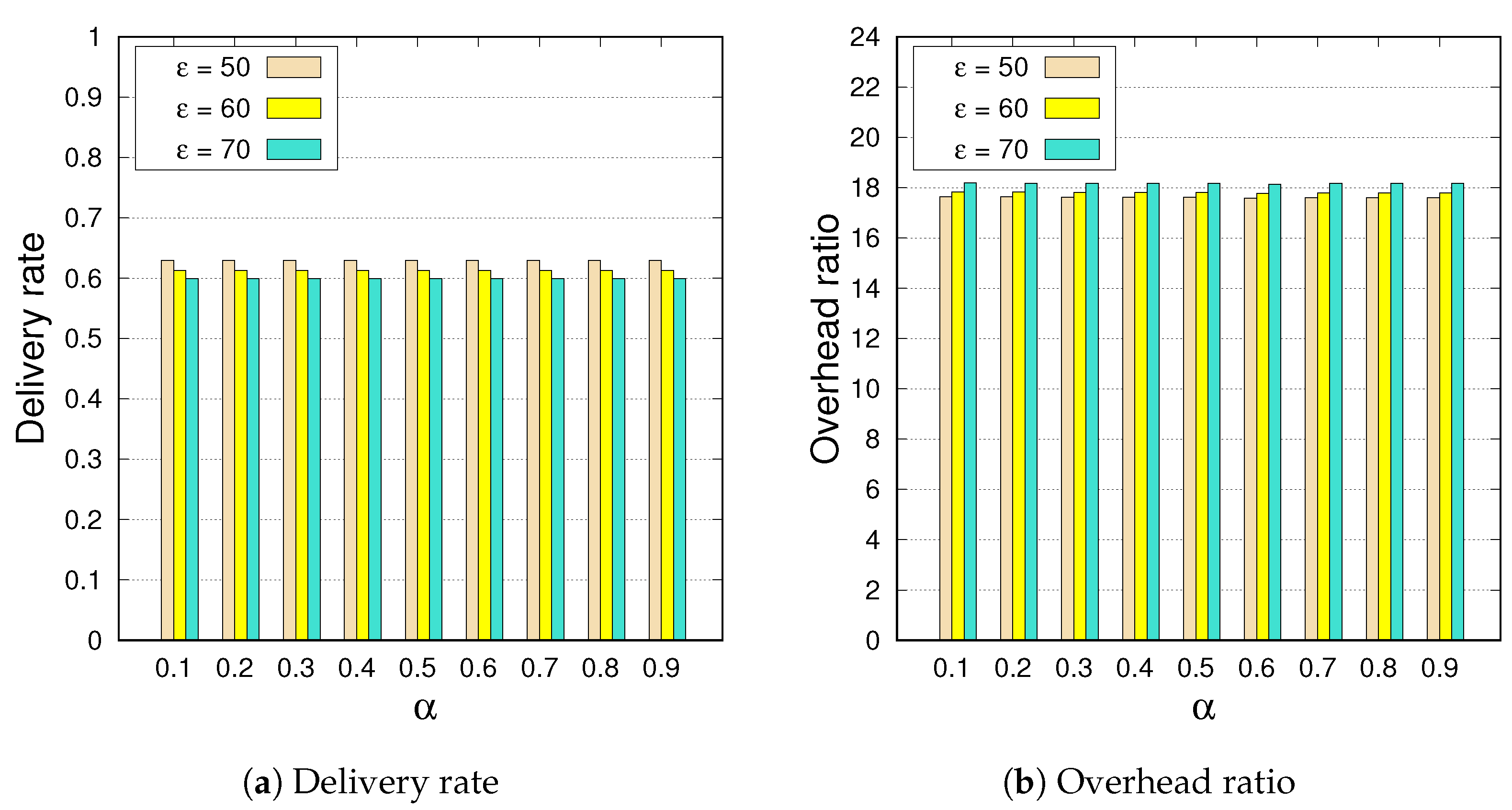
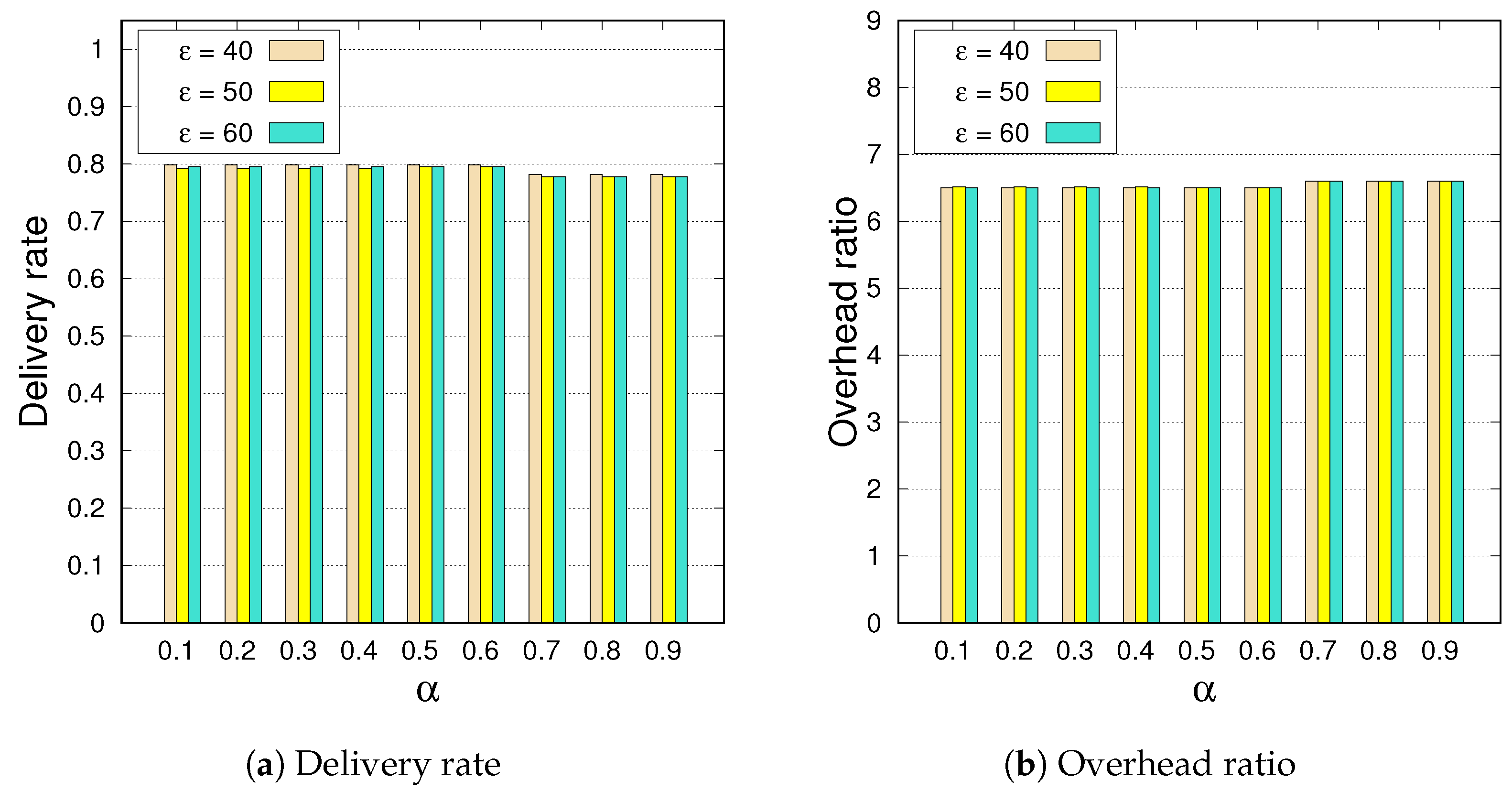
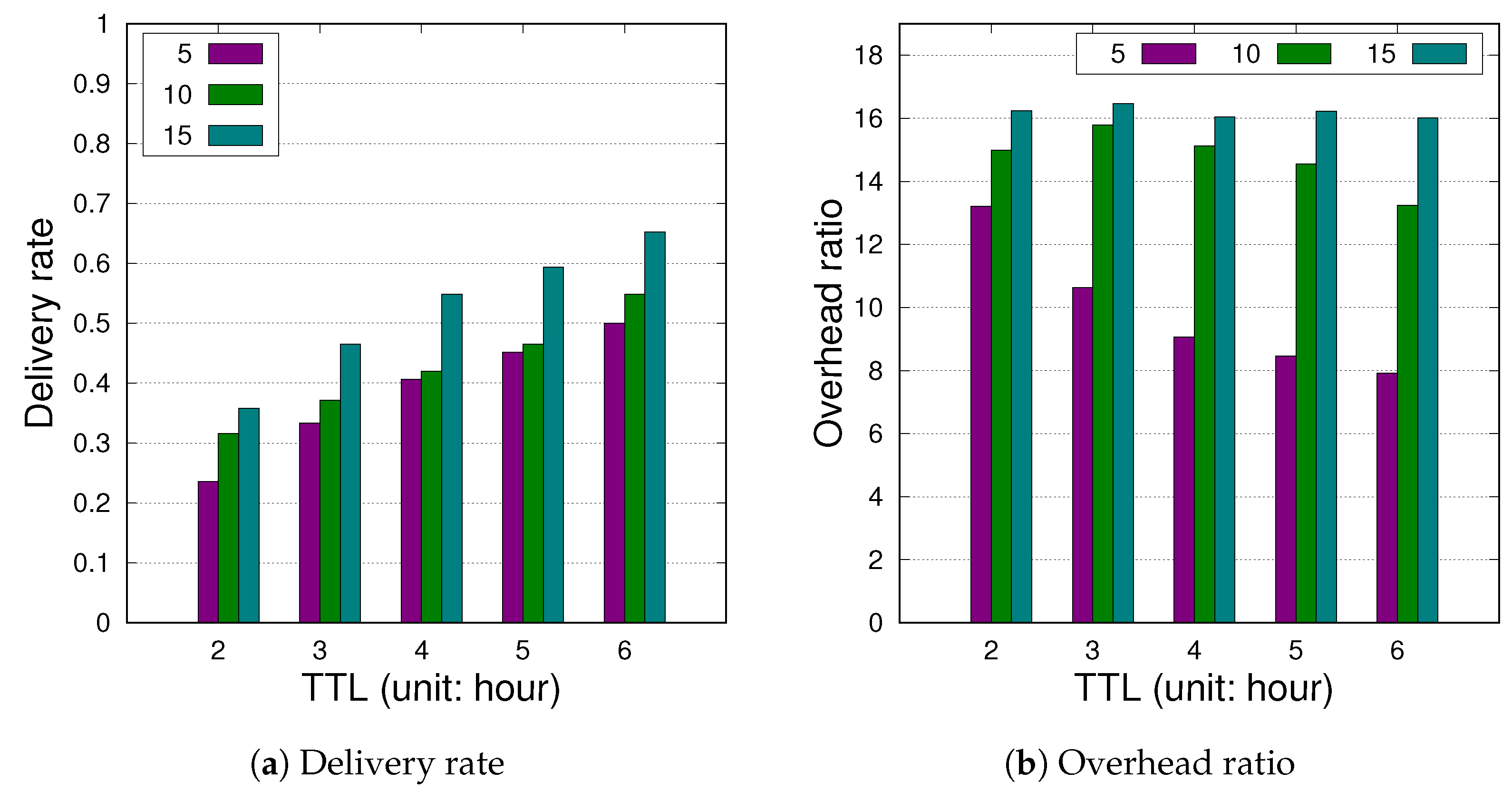
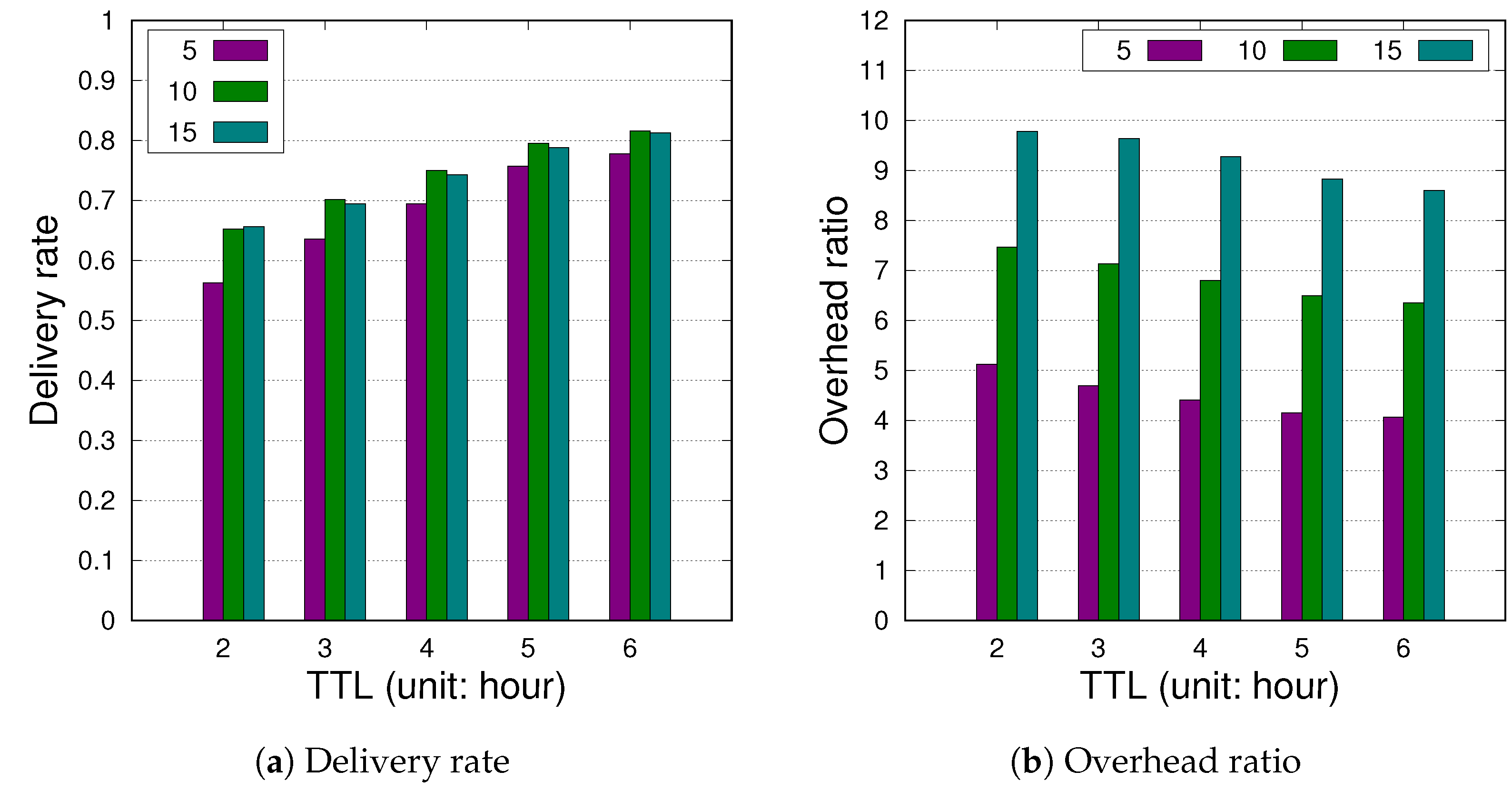
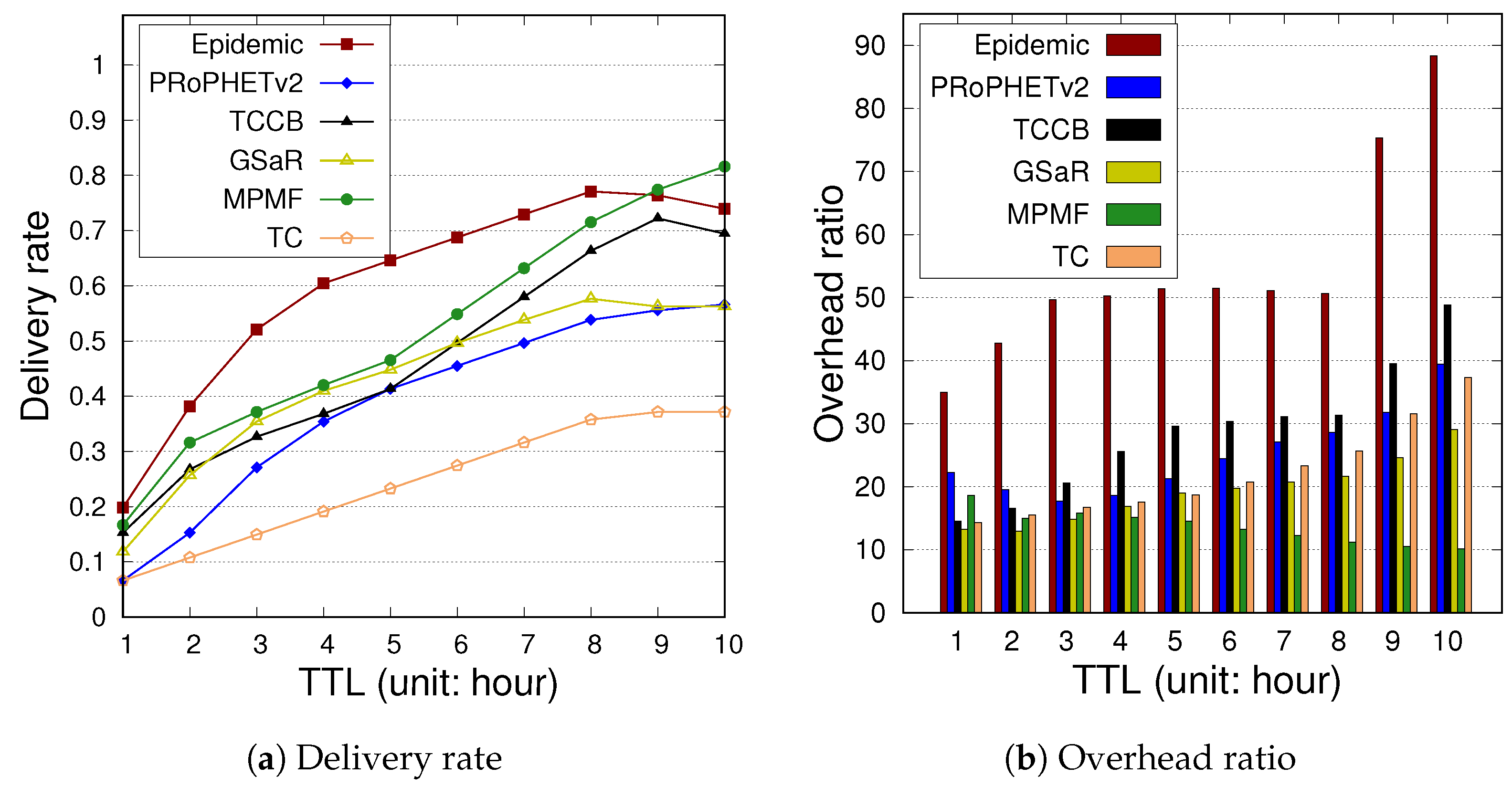
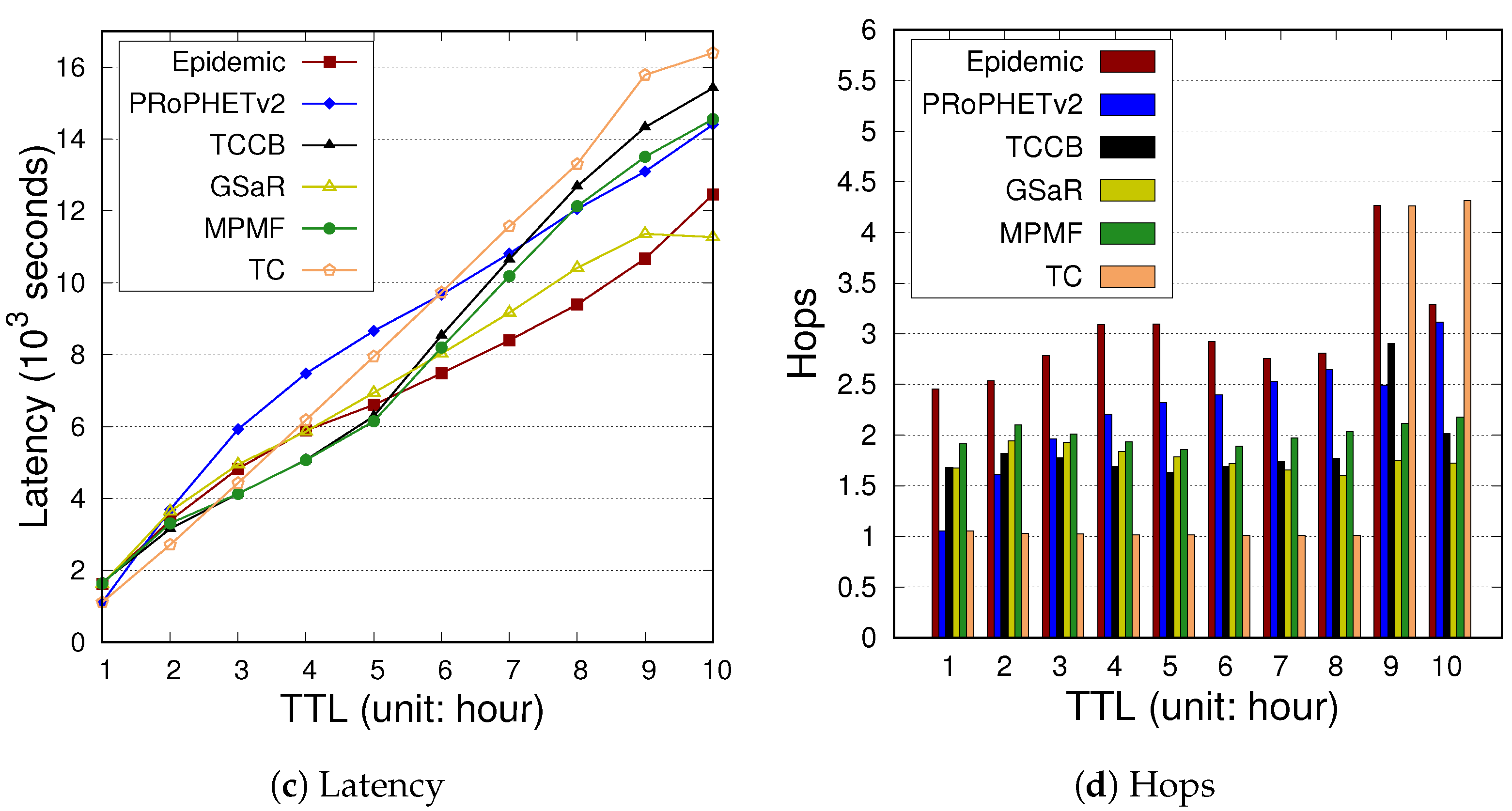
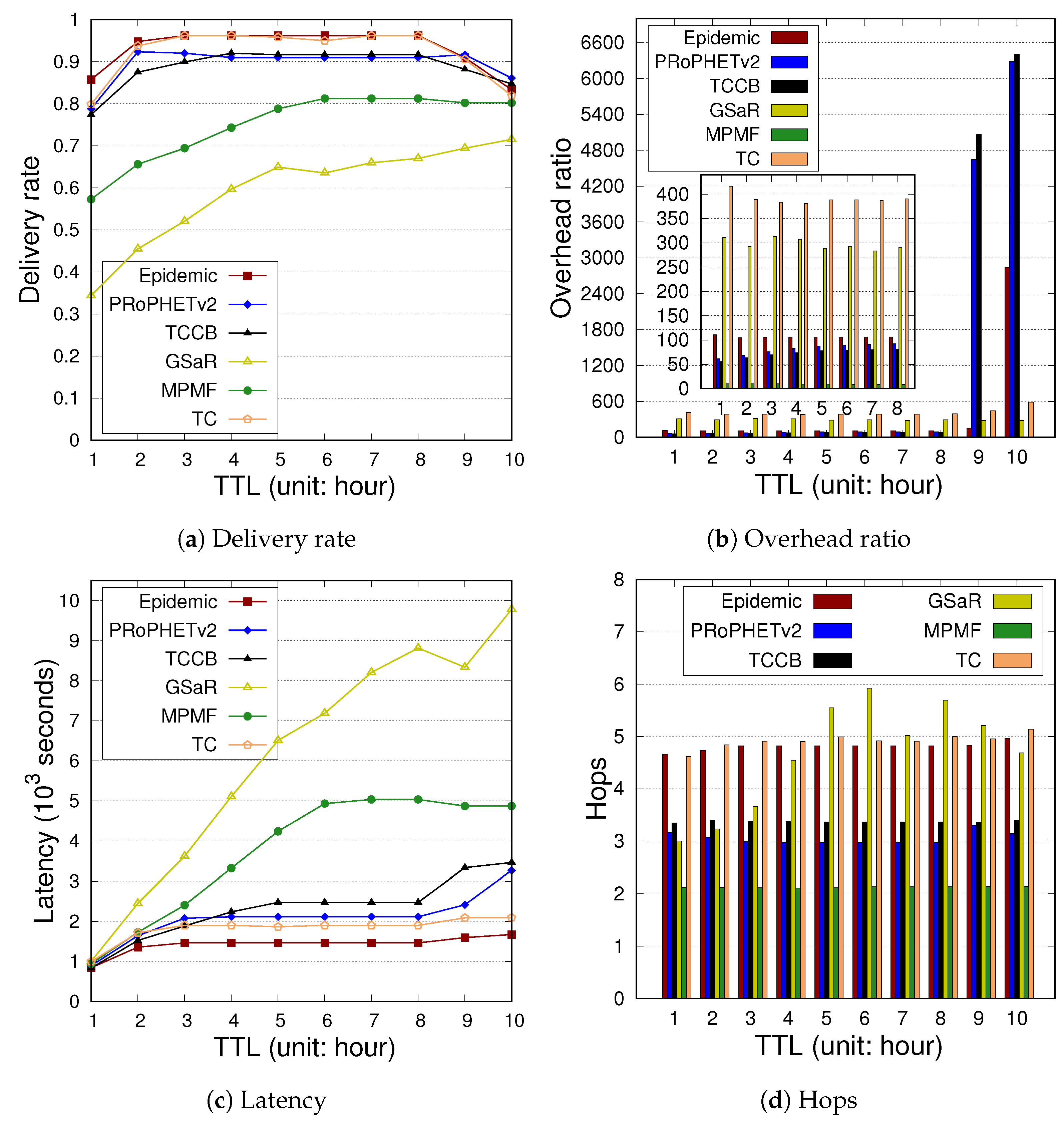
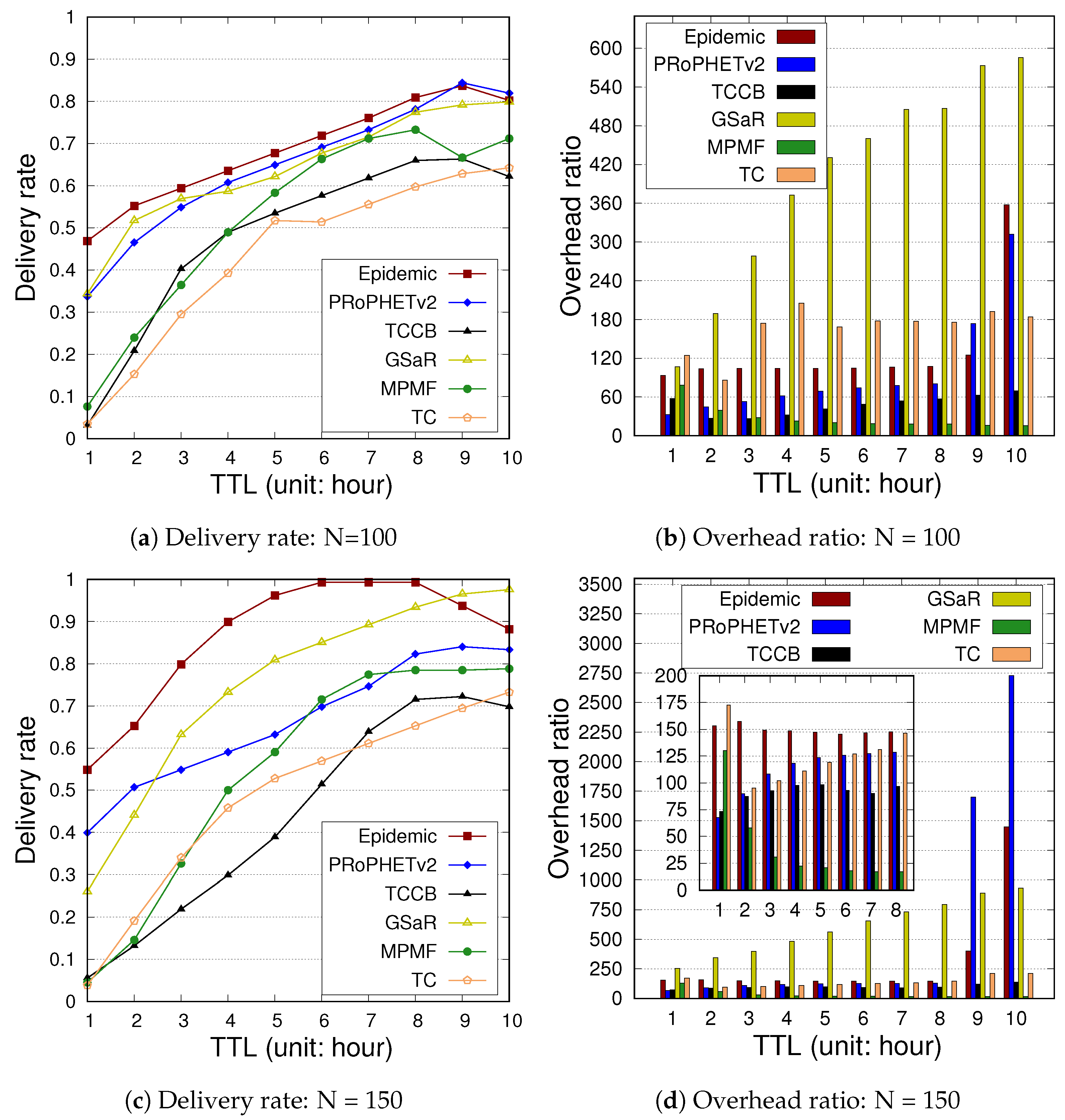
| Parameters | TVCM | NCCU |
|---|---|---|
| Number of nodes | 50 | 116 |
| Map size | 1500 × 1500 m | 3764 × 3420 m |
| Simulation time | 24 h | 24 h |
| Time-to-live (TTL) duration | 1 to 10 h | 1 to 10 h |
| Message size | 100 KB | 100 KB |
| Buffer size | 10 MB | 10 MB |
| Message creation intervals | 300 s | 300 s |
| Transmission speed | 2 MB/s | 2 MB/s |
| in MPMF | 0.6 | 0.5 |
| in MPMF | 50, 100, and 150 | 60 |
| in MPMF | 0.5 | 0.6 |
| Model | Node Population | TTL | Metric | Epidemic | PRoPHETv2 | TCCB | GSaR | MPMF | TC |
|---|---|---|---|---|---|---|---|---|---|
| TVCM | 50 | 1 | 1993 | 423 | 640 | 451 | 895 | 272 | |
| 2143 | 680 | 850 | 621 | 1104 | 529 | ||||
| 2104 | 2782 | 2488 | 2364 | 2578 | 2860 | ||||
| 123 | 10 | 29 | 36 | 35 | 2 | ||||
| 3 | 7445 | 1381 | 1938 | 1513 | 1690 | 720 | |||
| 6911 | 1531 | 2002 | 1030 | 1714 | 910 | ||||
| 5208 | 6089 | 5965 | 4676 | 7397 | 6877 | ||||
| 215 | 15 | 36 | 58 | 42 | 2 | ||||
| 5 | 9564 | 2533 | 3516 | 2453 | 1950 | 1254 | |||
| 7860 | 2572 | 3181 | 1047 | 1764 | 1367 | ||||
| 10,084 | 8912 | 8622 | 5566 | 12,998 | 10,067 | ||||
| 229 | 35 | 67 | 129 | 43 | 2 | ||||
| 7 | 10,724 | 3869 | 5190 | 3211 | 2225 | 2118 | |||
| 7820 | 3763 | 5896 | 967 | 1782 | 1991 | ||||
| 14,889 | 11,650 | 10,952 | 5983 | 17,906 | 2 | ||||
| 232 | 49 | 83 | 155 | 46 | 11,514 | ||||
| 10 | 18,816 | 6425 | 9762 | 4705 | 2382 | 3991 | |||
| 14,838 | 5718 | 7456 | 1244 | 1584 | 3495 | ||||
| 9732 | 12,538 | 8889 | 4674 | 24,896 | 11,586 | ||||
| 245 | 71 | 98 | 103 | 47 | 2 | ||||
| 100 | 1 | 12,748 | 3247 | 527 | 10,696 | 1493 | 1245 | ||
| 12,208 | 3253 | 783 | 3062 | 1677 | 1487 | ||||
| 1973 | 2072 | 2225 | 552 | 2236 | 2221 | ||||
| 671 | 123 | 24 | 479 | 54 | 14 | ||||
| 3 | 18,030 | 8528 | 3184 | 45,829 | 2679 | 14,795 | |||
| 15,078 | 7073 | 3265 | 6796 | 2420 | 14,208 | ||||
| 7789 | 5648 | 4613 | 836 | 7206 | 7016 | ||||
| 685 | 216 | 42 | 783 | 72 | 27 | ||||
| 5 | 20,559 | 13,100 | 6537 | 77,243 | 3209 | 25,144 | |||
| 15,207 | 10,073 | 6109 | 7688 | 2495 | 23,140 | ||||
| 12,816 | 9273 | 7624 | 974 | 12,265 | 1939 | ||||
| 694 | 237 | 93 | 917 | 73 | 32 | ||||
| 7 | 23,537 | 16,612 | 9797 | 104,336 | 3628 | 28,443 | |||
| 15,785 | 11,723 | 7689 | 7136 | 2487 | 24,456 | ||||
| 16,308 | 13,109 | 11,395 | 1055 | 16,736 | 3137 | ||||
| 713 | 278 | 105 | 989 | 76 | 37 | ||||
| 10 | 82,837 | 73,821 | 12,641 | 134,930 | 3162 | 34,108 | |||
| 73,073 | 67,239 | 8434 | 8178 | 1493 | 26,959 | ||||
| 4794 | 3239 | 12,656 | 997 | 21,054 | 4038 | ||||
| 834 | 456 | 111 | 1094 | 84 | 44 | ||||
| 150 | 1 | 24,395 | 7886 | 1174 | 19,029 | 1654 | 1898 | ||
| 23,037 | 7359 | 1214 | 2935 | 1810 | 2100 | ||||
| 2279 | 1866 | 2095 | 292 | 2477 | 1943 | ||||
| 952 | 358 | 45 | 376 | 79 | 6 | ||||
| 3 | 34,563 | 17,287 | 5837 | 72,682 | 2873 | 9997 | |||
| 29,557 | 14,323 | 4576 | 9084 | 2623 | 9535 | ||||
| 7493 | 6119 | 4355 | 593 | 7345 | 4245 | ||||
| 1159 | 467 | 153 | 1240 | 94 | 33 | ||||
| 5 | 41,085 | 22,687 | 11,011 | 131,691 | 3566 | 18,148 | |||
| 32,456 | 16,444 | 7333 | 12,276 | 2937 | 15,027 | ||||
| 12,330 | 10,013 | 6280 | 747 | 12,082 | 7547 | ||||
| 1224 | 544 | 166 | 1645 | 96 | 44 | ||||
| 7 | 42,257 | 27,591 | 16,575 | 188,247 | 3850 | 23,045 | |||
| 30,043 | 17,787 | 10,470 | 14,942 | 2867 | 16,390 | ||||
| 18,416 | 12,515 | 8861 | 935 | 17,760 | 11,298 | ||||
| 1223 | 582 | 189 | 1789 | 102 | 46 | ||||
| 10 | 368,546 | 654,804 | 28,053 | 262,574 | 3751 | 44,759 | |||
| 353,795 | 641,748 | 18,995 | 17,810 | 2365 | 34,547 | ||||
| 2109 | 635 | 11,355 | 823 | 26,109 | 6671 | ||||
| 1699 | 1740 | 292 | 2072 | 104 | 50 | ||||
| NCCU | 116 | 1 | 27,270 | 13,911 | 12,608 | 30,786 | 1646 | 96,105 | |
| 27,182 | 13,887 | 12,608 | 6468 | 1730 | 96,043 | ||||
| 2980 | 2546 | 2724 | 422 | 3113 | 700 | ||||
| 483 | 447 | 348 | 1162 | 51 | 278 | ||||
| 3 | 29,075 | 20,029 | 17,974 | 46,901 | 1927 | 106,515 | |||
| 27,749 | 19,872 | 17,396 | 12,402 | 1902 | 105,315 | ||||
| 9908 | 7894 | 8043 | 1538 | 9558 | 2378 | ||||
| 544 | 542 | 416 | 2116 | 50 | 334 | ||||
| 5 | 29,358 | 22,850 | 20,462 | 53,991 | 2005 | 107,222 | |||
| 25,794 | 21,409 | 19,331 | 15,259 | 1866 | 103,797 | ||||
| 17,086 | 13,875 | 13,891 | 3032 | 16,468 | 3990 | ||||
| 549 | 614 | 437 | 2733 | 50 | 349 | ||||
| 7 | 29,401 | 23,829 | 21,179 | 53,789 | 2012 | 107,362 | |||
| 23,411 | 20,875 | 18,727 | 15,963 | 1777 | 101,608 | ||||
| 24,283 | 20,411 | 20,535 | 4921 | 23,678 | 5328 | ||||
| 548 | 633 | 438 | 2787 | 50 | 332 | ||||
| 10 | 682,029 | 1,558,748 | 1,563,459 | 57,559 | 2010 | 138,850 | |||
| 673,928 | 1,553,953 | 1,559,990 | 16,017 | 1516 | 130,890 | ||||
| 915 | 331 | 304 | 7184 | 33,502 | 4864 | ||||
| 984 | 1392 | 1324 | 2882 | 48 | 336 |
Publisher’s Note: MDPI stays neutral with regard to jurisdictional claims in published maps and institutional affiliations. |
© 2022 by the authors. Licensee MDPI, Basel, Switzerland. This article is an open access article distributed under the terms and conditions of the Creative Commons Attribution (CC BY) license (https://creativecommons.org/licenses/by/4.0/).
Share and Cite
Mir, M.-Y.; Zhu, H.; Hu, C.-L. Enhanced Geographic Routing with One- and Two-Hop Movement Information in Opportunistic Ad Hoc Networks. Future Internet 2022, 14, 214. https://doi.org/10.3390/fi14070214
Mir M-Y, Zhu H, Hu C-L. Enhanced Geographic Routing with One- and Two-Hop Movement Information in Opportunistic Ad Hoc Networks. Future Internet. 2022; 14(7):214. https://doi.org/10.3390/fi14070214
Chicago/Turabian StyleMir, Mohd-Yaseen, Hengbing Zhu, and Chih-Lin Hu. 2022. "Enhanced Geographic Routing with One- and Two-Hop Movement Information in Opportunistic Ad Hoc Networks" Future Internet 14, no. 7: 214. https://doi.org/10.3390/fi14070214
APA StyleMir, M.-Y., Zhu, H., & Hu, C.-L. (2022). Enhanced Geographic Routing with One- and Two-Hop Movement Information in Opportunistic Ad Hoc Networks. Future Internet, 14(7), 214. https://doi.org/10.3390/fi14070214






